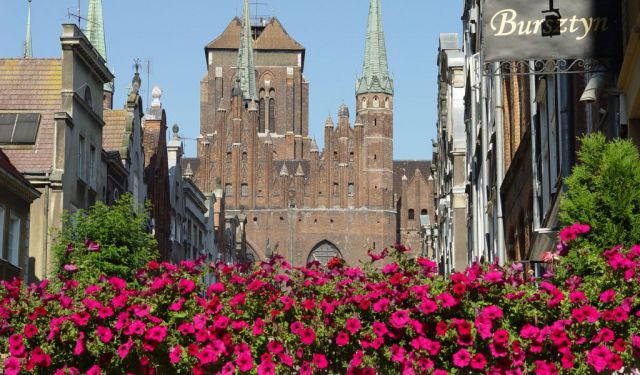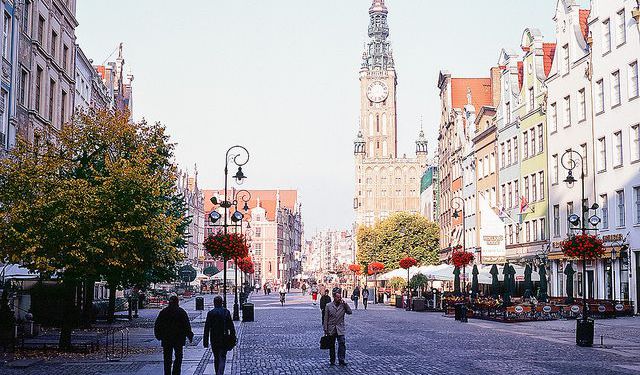Stocznia Gdańska (Gdańsk Shipyard), Gdansk
The Gdańsk Shipyard (Stocznia Gdańska) holds the distinction of being one of the largest shipyards globally. Its prominence reached a global scale in September 1980, as it became the epicenter for the birth of the Solidarity movement, or Solidarność in Polish. This marked the inception of organized opposition to Communist rule in Eastern Europe.
During that pivotal year, Gdańsk bore witness to a strike involving 17,000 shipbuilders, led by the shipyard electrician Lech Wałęsa. This labor action led to the official recognition of Solidarity as the first non-Communist trade union within the Soviet Bloc. This event represented one of the initial successful steps in a broader campaign of civil resistance that ultimately contributed to the eventual downfall of Communism across Eastern Europe.
The shipyard itself was established in 1946, occupying the site of former German shipyards, namely Schichau-Werft and Danziger Werft, both heavily damaged during World War II. During the era of the People's Republic of Poland, it was officially referred to as the Gdańsk Shipyard and Vladimir Lenin Shipyard in Gdańsk from 1967 to 1989. Additionally, in 1975, it was named "Westerplatte Heroes," in commemoration of The Battle of Westerplatte, which marked the beginning of World War II in Europe.
The shipyard's early launches occurred in 1948, involving the construction of fishing vessels such as smack and rescue boats for the Gdańsk Institute of Sea Fishing. Notably, it also produced the SS Sołdek, Poland's first seagoing vessel, which is now a museum ship. In 1949, the shipyard started making fishing lugo-trawlers. Then, from 1955, it focused on building troop landing craft, hydrographic ships, rescue vessels, training ships, and torpedo boats for navies like Poland, USSR, Bulgaria, Yugoslavia, and East Germany.
During that pivotal year, Gdańsk bore witness to a strike involving 17,000 shipbuilders, led by the shipyard electrician Lech Wałęsa. This labor action led to the official recognition of Solidarity as the first non-Communist trade union within the Soviet Bloc. This event represented one of the initial successful steps in a broader campaign of civil resistance that ultimately contributed to the eventual downfall of Communism across Eastern Europe.
The shipyard itself was established in 1946, occupying the site of former German shipyards, namely Schichau-Werft and Danziger Werft, both heavily damaged during World War II. During the era of the People's Republic of Poland, it was officially referred to as the Gdańsk Shipyard and Vladimir Lenin Shipyard in Gdańsk from 1967 to 1989. Additionally, in 1975, it was named "Westerplatte Heroes," in commemoration of The Battle of Westerplatte, which marked the beginning of World War II in Europe.
The shipyard's early launches occurred in 1948, involving the construction of fishing vessels such as smack and rescue boats for the Gdańsk Institute of Sea Fishing. Notably, it also produced the SS Sołdek, Poland's first seagoing vessel, which is now a museum ship. In 1949, the shipyard started making fishing lugo-trawlers. Then, from 1955, it focused on building troop landing craft, hydrographic ships, rescue vessels, training ships, and torpedo boats for navies like Poland, USSR, Bulgaria, Yugoslavia, and East Germany.
Want to visit this sight? Check out these Self-Guided Walking Tours in Gdansk. Alternatively, you can download the mobile app "GPSmyCity: Walks in 1K+ Cities" from Apple App Store or Google Play Store. The app turns your mobile device to a personal tour guide and it works offline, so no data plan is needed when traveling abroad.
Stocznia Gdańska (Gdańsk Shipyard) on Map
Sight Name: Stocznia Gdańska (Gdańsk Shipyard)
Sight Location: Gdansk, Poland (See walking tours in Gdansk)
Sight Type: Attraction/Landmark
Guide(s) Containing This Sight:
Sight Location: Gdansk, Poland (See walking tours in Gdansk)
Sight Type: Attraction/Landmark
Guide(s) Containing This Sight:
Walking Tours in Gdansk, Poland
Create Your Own Walk in Gdansk
Creating your own self-guided walk in Gdansk is easy and fun. Choose the city attractions that you want to see and a walk route map will be created just for you. You can even set your hotel as the start point of the walk.
Gdansk's Historical Churches Tour
Gdansk has a long history of Catholicism, hence the abundance of spectacular churches here. Let's delve into some of the most impressive temples that grace the cityscape and see what they are.
Saint John's Church, a Gothic masterpiece, stands tall in the heart of Gdansk. It dates back to the 14th century and features impressive brickwork and intricate details. Its towering spire is a... view more
Tour Duration: 1 Hour(s)
Travel Distance: 1.6 Km or 1 Miles
Saint John's Church, a Gothic masterpiece, stands tall in the heart of Gdansk. It dates back to the 14th century and features impressive brickwork and intricate details. Its towering spire is a... view more
Tour Duration: 1 Hour(s)
Travel Distance: 1.6 Km or 1 Miles
Gdansk Introduction Walking Tour
The most probable source for the name, "Gdansk" seems to be "Gdania", the ancient name of the river Motlawa. Gdansk began with agriculture and fishing and trade with Pomerania in the 9th century. It was annexed by Mieszko, Duke of Poland, in 975.
The center of town was the Long Market, with its craftsmen. German merchant settlements grew by St Nicholas Church. Gdansk joined... view more
Tour Duration: 2 Hour(s)
Travel Distance: 2.2 Km or 1.4 Miles
The center of town was the Long Market, with its craftsmen. German merchant settlements grew by St Nicholas Church. Gdansk joined... view more
Tour Duration: 2 Hour(s)
Travel Distance: 2.2 Km or 1.4 Miles
Solidarity Union Walking Tour
For decades, the word 'Solidarity' (Polish: Solidarność) has been synonymous with the city of Gdansk. The peaceful Solidarity revolution, started here in the August of 1980, marked the outset of the fall of communism not only in Poland but also throughout Eastern Europe.
Stemmed from the country's first free labor union born out of strikes at the Lenin Shipyard (now the Gdansk... view more
Tour Duration: 1 Hour(s)
Travel Distance: 0.8 Km or 0.5 Miles
Stemmed from the country's first free labor union born out of strikes at the Lenin Shipyard (now the Gdansk... view more
Tour Duration: 1 Hour(s)
Travel Distance: 0.8 Km or 0.5 Miles






